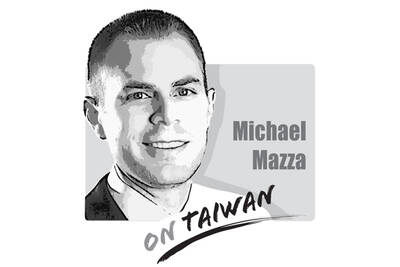Since President Ma Ying-jeou’s (馬英九) administration assumed office, unemployment has continued to set record highs. While government statistics show that unemployment hit 5.94 percent in June, US ratings agency Moody’s pointed out that the figure would be 7.1 percent if the percentage of the population forced to take unpaid leave is included.
A recent survey by Taiwan Thinktank found 12.7 percent of respondents to be either unemployed or seeking work, with approximately 30.6 percent of households suffering from unemployment. But instead of focusing on fundamental problems, the government has pinned its hopes on the signing of an economic cooperation framework agreement (ECFA) with China, saying that the pact will create 270,000 jobs. Can we really believe these statements?
The biggest concern is the potential unemployment an ECFA with China could cause. The survey also suggested that 50.8 percent of respondents did not agree with the government, which has said: “The signing of an ECFA with China would substantially reduce domestic unemployment.”
The survey said that the number of respondents who agreed with what the government has said about an ECFA only accounted for half of those who disagreed.
In addition, Chiu Jiunn-rong (邱俊榮), vice dean of the School of Management at National Central University, said the Global Trade Analysis Project model used in a report published by the Chung-Hua Institution for Economic Research was based on the assumption that there is full employment in the market. Chiu said the report was therefore incapable of estimating how an ECFA would affect Taiwan’s domestic job market.
However, the Ministry of Economic Affairs (MOEA) has repeatedly cited this report when stating that a pact with China would increase employment.
In addition, the government has not explained what an ECFA with China would entail. How can the public be expected to believe it will create jobs? A public opinion poll showed that 90 percent of respondents said they did not understand the proposed agreement’s content and 90 percent of respondents considered it necessary for the MOEA to publicize the details of an ECFA along with an objective assessment to give the public a better understanding of the matter.
The poll also said 80 percent of respondents disagreed with the content of the controversial cartoons the MOEA recently released, which depicted opponents to an ECFA as poorly educated and supporters as intellectually and socially superior.
The government should not push through such a controversial agreement against the will of the public. There have been many examples of economic affairs being put to a referendum in other countries. For instance, Denmark and Sweden made a referendum part of the approval procedure for their participation in European economic integration in 2000 and 2003 respectively.
Now that civic groups have completed the first stage of their application to hold a referendum on an ECFA, the government should not waste public funds promoting an economic pact with China or provide us with “professional assessments” to cover up the potential impact of the agreement. The government should make the contents of an ECFA public and engage the public in detailed discussion on what impact it may have on all aspects of our lives.
Whether to sign an ECFA should be decided by the public. Taiwan Thinktank is ready for a debate on the ECFA with the government, but is the government ready to discuss the matter openly?
Cheng Li-chiun is the chief executive officer of Taiwan Thinktank.
TRANSLATED BY TED YANG
The US Senate’s passage of the 2026 National Defense Authorization Act (NDAA), which urges Taiwan’s inclusion in the Rim of the Pacific (RIMPAC) exercise and allocates US$1 billion in military aid, marks yet another milestone in Washington’s growing support for Taipei. On paper, it reflects the steadiness of US commitment, but beneath this show of solidarity lies contradiction. While the US Congress builds a stable, bipartisan architecture of deterrence, US President Donald Trump repeatedly undercuts it through erratic decisions and transactional diplomacy. This dissonance not only weakens the US’ credibility abroad — it also fractures public trust within Taiwan. For decades,
The government and local industries breathed a sigh of relief after Shin Kong Life Insurance Co last week said it would relinquish surface rights for two plots in Taipei’s Beitou District (北投) to Nvidia Corp. The US chip-design giant’s plan to expand its local presence will be crucial for Taiwan to safeguard its core role in the global artificial intelligence (AI) ecosystem and to advance the nation’s AI development. The land in dispute is owned by the Taipei City Government, which in 2021 sold the rights to develop and use the two plots of land, codenamed T17 and T18, to the

The ceasefire in the Middle East is a rare cause for celebration in that war-torn region. Hamas has released all of the living hostages it captured on Oct. 7, 2023, regular combat operations have ceased, and Israel has drawn closer to its Arab neighbors. Israel, with crucial support from the United States, has achieved all of this despite concerted efforts from the forces of darkness to prevent it. Hamas, of course, is a longtime client of Iran, which in turn is a client of China. Two years ago, when Hamas invaded Israel — killing 1,200, kidnapping 251, and brutalizing countless others
Taiwan’s first case of African swine fever (ASF) was confirmed on Tuesday evening at a hog farm in Taichung’s Wuci District (梧棲), trigging nationwide emergency measures and stripping Taiwan of its status as the only Asian country free of classical swine fever, ASF and foot-and-mouth disease, a certification it received on May 29. The government on Wednesday set up a Central Emergency Operations Center in Taichung and instituted an immediate five-day ban on transporting and slaughtering hogs, and on feeding pigs kitchen waste. The ban was later extended to 15 days, to account for the incubation period of the virus